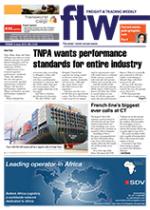Rail is gradually clawing
back market share in South
Africa despite ongoing
pessimism around its
capacity and efficiency.
According to Professor
Jan Havenga, director at
the Centre for Supply
Chain Management
at Stellenbosch
University, this
is substantiated
by the research
for the annual
State of Logistics
survey released
recently.
“And it is
something that
we should be
welcoming, especially in light
of logistics costs continuing
to increase,” he told FTW.
“For over 20 years Transnet
Freight Rail moved around
180 million tons of cargo
per annum. There was no
major change in the tonnage,
yet, from the moment the
perspective on
investment
changed some
seven years
ago, we have
seen volumes
increase.”
Sandra
Gertenbach,
executive
manager of
TFR, agreed
saying the
organisation was now
moving more than 207
million tons per year.
“In terms of investment
alone we have made
significant progress if you
think that ten years ago
we invested R2.4 billion
compared to last year’s R18
billion,” she told FTW.
Havenga said while many
in the industry remained
unconvinced about rail’s
progress, the figures were
proving that cargo was being
moved back to rail.
“And yes, it has been
mostly on the bulk side and
not general cargo, and there
are many lines that are
under-utilised such as the
Cape Corridor for instance,
but that will all come,” he
said. “The reality is that we
are going to
have to be
patient. It
is not going
to happen overnight, but
as the elements come into
place, the infrastructure
is upgraded and more
collaboration takes place
between TFR and its
customers, I believe we will
start to see more volumes on
rail in this country.”
Gertenbach said their
projections were to have at
least 350 million tons of
cargo on rail before 2020.
“We understand though
that we cannot do it alone
and therefore agreements
with the big logistics service
providers in the country
are crucial to the success of
the road to rail strategy,”
she said. “We also know
that we have to build more
credibility with the industry.
We have to be more reliable,
more predictable and be
more customer-centric, but
there is change happening
already.”
Havenga said the 10th
State of Logistics survey
supported this and found
that the public sector needed
to create a more enabling
environment for effective
logistics. “There is going to
have to be a greater drive
towards intermodalism
as this is a key enabler to
reduce costs and improve
the country’s overall logistics
performance.”
According to Havenga,
a significant change in
attitude towards rail is also
needed. “We cannot continue
as we are at present. The
costs are increasing year
on year and we now have a
model, one of a few in the
world, to show us exactly
where our costs lie – and
logistics costs are influenced
more than anything else
by the fuel price. Changing
that means understanding
the very real need for
intermodality and using rail
far more frequently.”
INSERT & CAPTION
As more collaboration
takes place
between TFR and its
customers, I believe
we will start to see
more volumes on rail
in this country.
– Jan Havenga

